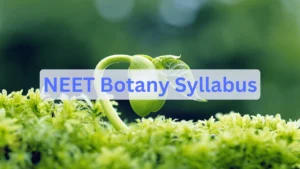Table of Contents
The National Eligibility cum Entrance Test (NEET) is a national level entrance exam conducted by the National Testing Agency (NTA) every year to admit students for the medial courses like MBBA and BDS. Students who have completed their class 12th or equivalent level of education from a recognized board or institution having biology as one of the main subjects must now complete their preparations for the NEET UG Exam 2025 by studying all the topics mentioned on the NEET Syllabus 2025 and solving the NEET Previous Year Question Papers. The article below shared the NEET Biology Previous Year Question Paper for all the aspirants.
NEET Biology Previous Year Question Paper
The NTA has announced the conduction of the NEET UG Exam 2025 on May 04, 2025 for the admission into academic session 2025-26. The students preparing for the NEET Exam must note that the NEET Biology section has been divided into two sections named Zoology and Botany.
During the preparation phase, it is important that all the students must try to solve as many NEET Biology Previous Year Question Papers as they can, as it will not only help them understand the exam pattern but will also boost their confidence going into the exam hall.
| Particulars | Details |
| Name of Examination |
National Eligibility cum Entrance Test 2025
|
| NEET UG Conducting Authority |
National Testing Agency (NTA)
|
| Type of Questions |
Multiple Choice Based Questions (MCQ)
|
| NEET UG Exam Date |
May 04, 2025
|
| Total Questions | 180 |
| Total Duration | 180 Minutes |
| Total Marks | 720 marks |
| Marks for Correct Answer | 4 marks |
| Negative Marking for Wrong Answers | -1 marks |
NEET Biology Previous Year Question Paper Download PDF
All the aspirants of NEET Exam 2025 must test their preparations for the Biology section by solving as many NEET Biology Previous Year Question Papers as possible. To help students find the NEET Biology PYQs, we will add the direct link connecting to a new window where all the PYQs will be available for download. Aspirants will have to just click on the download icon and then solve them to complete their preparations for the exam.
Why NEET Biology Previous Year Question Paper?
Solving NEET Biology Previous Year Question Paper will help students in multiple ways like:
- Understand the Exam Pattern: Solving the NEET Biology Previous Year Question Paper will help students understand the exam pattern as the PYQs follow the exam pattern followed in previous years
- Time Management: One of the biggest benefits of solving NEET Biology Previous Year Question Paper is to understand and get used to with time management as by regularly solving the mock tests, students will be able to get used to with the time period allocated to solve the question paper
- Performance Analysis: After solving every NEET Biology Previous Year Question Paper, students will be able to analyze their performance and highlight their weaknesses to work over them
- Confidence Building: Solving more and more NEET Biology Previous Year Question Paper successfully will help students gain confidence for the exam day and will ultimately help them score high in the exam
NEET Biology Previous Year Questions with Answers
Q1. Lecithin, a small molecular weight organic compound found in living tissues, is an example of:
A. Amino acids
B. Phospholipids
C. Glycerides
D. Carbohydrates
Answer: B
Solution: Some lipids have phosphorous and a phosphorylated organic compound in them. These are phospholipids. They are found in the cell membrane. Lecithin is one example. Option (3) is incorrect as glycerides are another group of lipids in which both glycerol and fatty acids are present. Options (1) and (2) are incorrect as amino acids and carbohydrates are separate groups of biomolecules.
Q2. Hind II always cuts DNA molecules at a particular point called recognition sequence and it consists of:
A. 8 bp
B. 6 bp
C. 4 bp
D. 10 bp
Answer: B
Solution: The first restriction endonuclease – Hind II, whose functioning depends on a specific DNA nucleotide sequence was isolated. It was found that Hind II always cut DNA molecules at a particular point by recognising a sequence of six base pairs. Option (1), (3), and (4) are incorrect because they have either more than 6 or less than 6 bp.
Q3. The capacity to generate a whole plant from any cell of the plant is called:
A. Totipotency
B. Micropropagation
C. Differentiation
D. Somatic hybridization
Answer: B
Solution: Totipotency is defined as the capacity to generate a whole plant from any cell of the plant.
Q4. Given below are two statements:
Statement I : Bt toxins are insect group specific and coded by a gene cry IAc.
Statement II : Bt toxin exists as inactive protoxin in B. thuringiensis.
However, after ingestion by the insect the inactive protoxin gets converted into active form due to acidic pH of the insect gut. In the light of the above statements, choose the correct answer from the options given below:
A. Both Statement I and Statement II are true
B. Both Statement I and Statement II are false
C. Statement I is true but Statement II is false
D. Statement I is false but Statement II is true
Answer: C
Solution: The correct answer is option (3) as specific Bt toxin genes were isolated from Bacillus thuringiensis and incorporated into the several crop plants such as cotton. The choice of genes depends upon the crop and the targeted pest as most Bt toxins are insect- group specific. The toxin is coded by a gene named cry. There are a number of them, for example, the proteins encoded by the genes cry IAc and cry IIAb control the cotton bollworms, that of cry IAb controls corn borer.
Q5. The type of conservation in which the threatened species are taken out from their natural habitat and placed in special setting where they can be protected and given special care is called
A. in-situ conservation
B. Biodiversity conservation
C. Semi-conservative method
D. Sustainable development
Answer: B
Solution: The type of conservation in which threatened species are taken out from their natural habitat and placed in special setting where they can be protected and given special care is called ex-situ conservation which is a type of biodiversity conservation.



 NEET UG 2025: Is NEET Previous years Que...
NEET UG 2025: Is NEET Previous years Que...
 NEET Botany Syllabus 2025 Out, Check Cha...
NEET Botany Syllabus 2025 Out, Check Cha...
 NEET Cut Off: NEET 2025 Safe Score By Ca...
NEET Cut Off: NEET 2025 Safe Score By Ca...



